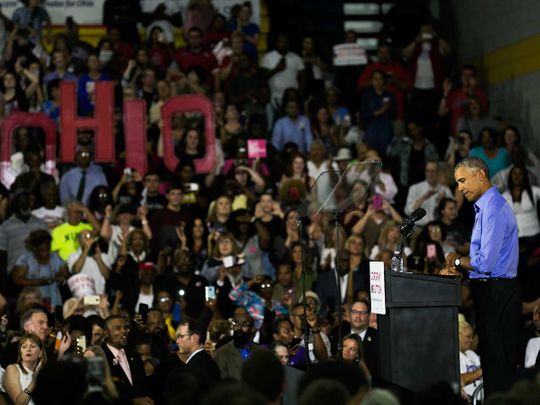
Washington: Just after Donald Trump was elected president, Barack Obama slumped in his chair in the Oval Office and addressed an aide standing near a conspicuously placed bowl of apples, emblem of a healthy-snacking policy soon to be swept aside, along with so much else.
“I am so done with all of this,” Obama said of his job, according to several people familiar with the exchange.
Yet he knew, even then, that a conventional White House retirement was not an option. Obama, 55 at the time, was stuck holding a baton he had wanted to pass to Hillary Clinton, and saddled with a successor whose fixation on him, he believed, was rooted in a bizarre personal animus and the politics of racial backlash exemplified by the birther lie.
“There is no model for my kind of post-presidency,” he told the aide. “I’m clearly renting space inside the guy’s head.”
Which is not to say that Obama was not committed to his pre-Trump retirement vision - a placid life that was to consist of writing, sun-flecked fairways, policy work through his foundation and family time aplenty at a new $11.7 million spread on Martha’s Vineyard.
Still, more than three years after his exit, the 44th president of the United States is back on a political battlefield, drawn into the fight by an enemy, Trump, who is hellbent on erasing him, and by a friend, Joe Biden, who is equally intent on embracing him.
The stakes of that reengagement were always going to be high. Obama is nothing if not protective of his legacy, especially in the face of Trump’s many attacks. Yet interviews with more than 50 people in the former president’s orbit portray a conflicted combatant, trying to balance deep anger at his successor with an instinct to refrain from a brawl that he fears may dent his popularity and challenge his place in history.
That calculus, though, may be changing in the wake of George Floyd’s killing by police in Minneapolis. As America’s first Black president, Obama sees the current social and racial awakening as an opportunity to elevate a 2020 election dictated by Trump’s mud-wrestling style into something more meaningful - to channel a new, youthful movement toward a political aim, as he did in 2008.
He is doing so carefully, characteristically intent on keeping his cool, his reputation, his political capital and his dreams of a retirement intact.
“I don’t think he is hesitant. I think he is strategic,” said Dan Pfeiffer, a top adviser for more than a decade. “He has always been strategic about using his voice; it’s his most valuable commodity.”
Many supporters have been pressing him to be more aggressive.
“It would be nice, for a change, if Barack Obama could emerge from his cave and offer - no wait, DEMAND - a way forward,” columnist Drew Magary wrote in a much-shared Medium post in April titled “Where the Hell is Barack Obama?”
The counterargument: He did his job and deserves to be left alone.
Stuck in the middle
Obama’s head appears to be somewhere in the middle. He is still anguishing over the publication date of his long-awaited memoir. But last week he stepped up his nominally indirect criticism of Trump’s administration - decrying a “shambolic, disorganised, mean-spirited approach to governance” during an online Biden fundraiser. And he made a pledge of sorts, telling Biden’s supporters: “Whatever you’ve done so far is not enough. And I hold myself and Michelle and our kids to that same standard.”
On Thursday, during an invitation-only Zoom fundraiser, Obama expressed outrage at the president’s use of “kung flu” and “China virus” to describe the coronavirus. “I don’t want a country in which the president of the United States is actively trying to promote anti-Asian sentiment and thinks it’s funny. I don’t want that. That still shocks and pisses me off,” Obama said, according to a transcript of his remarks provided by a participant in the event.
Obama speaks with the former vice-president and top campaign aides frequently, offering suggestions on staffing and messaging. Last month, he bluntly counselled Biden to keep his speeches brief, interviews crisp and slash the length of his tweets, the better to make the campaign a referendum on Trump and the economy, according to Democratic officials.
He has taken a particular interest in Biden’s work-in-progress digital operation, the officials said, enlisting powerful friends, like LinkedIn founder Reid Hoffman and former Google chief executive Eric Schmidt, to share their expertise, they said.
Yet he continues to slow-walk some requests, especially to headline more fundraisers. Some in Obama’s camp suggest he wants to avoid overshadowing the candidate - which Biden’s people are not buying.
“By all means, overshadow us,” one of them joked.
Minimalist approach
From the moment Trump was elected, Obama adopted a minimalist approach: He would critique his policy choices, not the man himself, following the norm of civility observed by his predecessors, especially George W. Bush.
But norms are not Trump’s thing. He made it clear from the start that he wanted to eradicate any trace of Obama’s presence from the West Wing. “He had the worst taste,” Trump told a visitor in early 2017, showing off his new curtains - which were not terribly different from Obama’s, in the view of other people who tramped in and out of the office during that chaotic period.
The cancellation was more pronounced when it came to policy. One former White House official recalled Trump interrupting an early presentation to make sure one staff proposal was not “an Obama thing.”
During the transition, one Trump aide got the idea of printing out the detailed checklist of Obama’s campaign promises from the official White House website to repurpose as a kind of hit list, according to two people familiar with the effort.
“This is personal for Trump; it is all about President Obama and demolishing his legacy. It’s his obsession,” said Omarosa Manigault Newman, an “Apprentice” veteran and, until her departure, one of the few Black officials in Trump’s West Wing. “President Obama will not be able to rest as long as Trump is breathing.”
As the transition dragged on, Obama became increasingly uneasy at what he saw as the indifference of the new president and his inexperienced team. Many of them ignored the briefing binders his staff had painstakingly produced at his direction, former Obama aides recalled.
As for Trump, he had “no idea what he’s doing,” Obama told an aide after their Oval Office encounter.
Former advisers
During the transition, Paulette Aniskoff, a veteran West Wing aide, began assembling a political organisation of former advisers to help Obama defend his legacy, aid other Democrats and plan for his deployment as a surrogate in the 2018 midterms.
He was open to the effort, but his eye was on the exits. “I’ll do what you want me to do,” he told Aniskoff’s team, but mandated they carefully screen out any appearances that would waste time or squander political capital.
Obama was, then as now, so determined to avoid uttering the new president’s name that one aide jokingly suggested they refer to him as “He-Who-Must-Not-Be-Named” - Harry Potter’s archenemy, Lord Voldemort.
Trump had no trouble naming names. In March 2017, he falsely accused Obama of personally ordering the surveillance of his campaign headquarters, tweeting, “How low has President Obama gone to tap my phones during the very sacred election process. This is Nixon/Watergate. Bad (or sick) guy!”
It was an inflection point of sorts. Obama told Aniskoff’s team he would call out his successor by name in the 2018 midterms. But not a lot.
It was telling how Obama talked about Trump that fall: He referred to him less as a person than as a kind of epidemiological affliction on the body politic, spread by his Republican enablers.
“It did not start with Donald Trump - he is a symptom, not the cause,” he said in his kickoff speech at the University of Illinois in September 2018. The American political system, he added, was not “healthy” enough to form the “antibodies” to fight the contagion of “racial nationalism.”
Cries for racial justice
The rising cries for racial justice have lent the 2020 campaign a coherence for Obama, a politician most comfortable cloaking his criticism of an opponent in the language of movement politics.
Obama’s first reaction to the protests, people close to him said, was anxiety - that the spasms of rioting would spin out of control and play into Trump’s narrative of a lawless left.
But peaceful demonstrators took control, igniting a national movement that challenged Trump without making him its focal point.
Soon after, in the middle of a strategy call with political aides and policy experts at his foundation, an excited Obama pronounced that “a tailor-made moment” had arrived.
His response to the Floyd killing was less about hammering Trump than about encouraging young people, who have been slow in embracing Biden, to vote. When he chose to speak publicly, it was to host an online forum highlighting a slate of policing reforms that went nowhere in his second term.
In that sense, the role he is most comfortable occupying is the job he was once so over.








